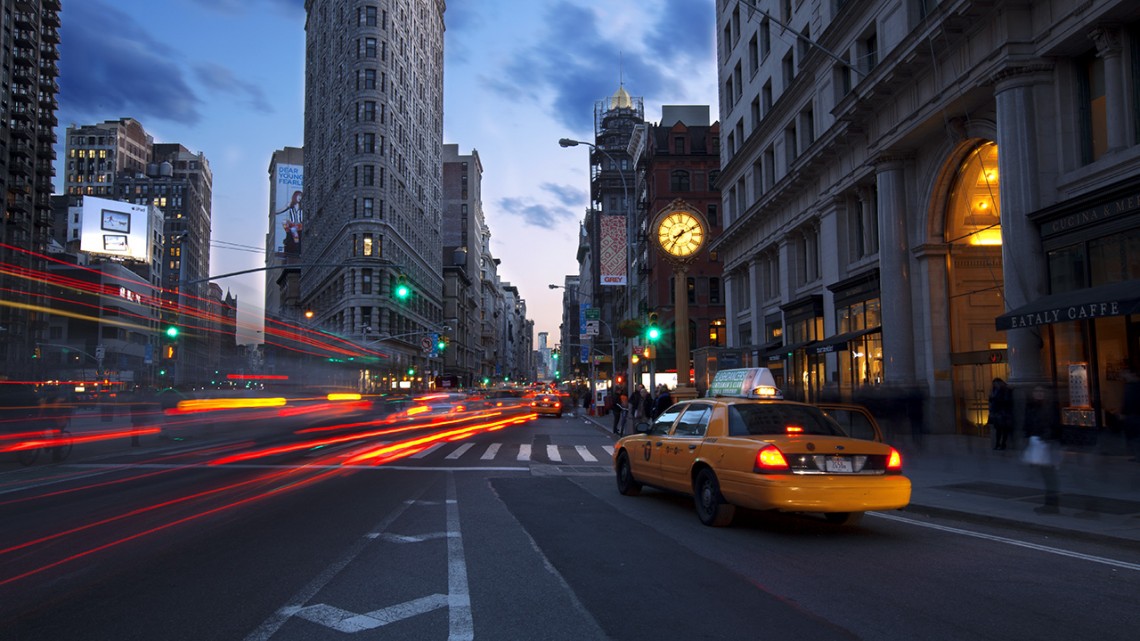
A new study quantified, for the first time, how many taxis equipped with sensors would be needed for accurate, real-time data about the health of cities.
How many taxis can scan a city? Fewer than you’d think
By Melanie Lefkowitz
Just 10 taxis equipped with mobile sensors can survey a third of Manhattan’s streets in a day, inexpensively gathering valuable data about factors such as air quality, street conditions and bridge stability to provide an accurate and timely snapshot of a city’s health, according to a new study.
The researchers also found that the pattern of taxi movement was strikingly similar among cities in North America, Europe and Asia, despite differences in traffic patterns, driving habits and the needs of individual passengers.
“That’s the triumph of this analysis – to see the universality in what you would think was tremendous particularity, because the cities are such different sizes and the drivers have different cultures and there are different amounts of congestion,” said Steven Strogatz, Cornell’s Jacob Gould Schurman Professor of Applied Mathematics.
Strogatz contributed to “Quantifying the Sensing Power of Vehicle Fleets,” which published June 11 in the Proceedings of the National Academy of Sciences. The study was led by researchers from the Massachusetts Institute of Technology’s Senseable City Lab.
Sensors are a relatively inexpensive and increasingly popular way to track the health of cities. Stationary sensors, such as those affixed to utility poles, can provide detailed data, but they cover only a small range. Mobile sensors like satellites offer wide coverage, but only for brief time periods. Attaching sensors to vehicles combines the advantages of both models, and using existing vehicles doesn’t require extra fuel.
Previous research on drive-by sensing has focused on the development of the sensors. In this study, the researchers calculated for the first time how many taxis would be needed to provide adequate data about a city. First author Kevin P. O’Keeffe, Ph.D. ’17, a postdoctoral researcher at the Senseable City Lab, started by examining datasets from New York City, where the number of taxis is fixed at around 13,000.
“That was a dream test case, because there are loads of taxis, high demand and Manhattan is an island,” O’Keeffe said.
He found that the extent to which taxis can scan the city is “unexpectedly large,” with just 10 randomly chosen cabs needed to cover a third of Manhattan’s 8,000 streets. “I did all the calculations and simulations twice to make sure I hadn’t made a mistake, but the results turned out to be correct,” he said.
However, the researchers found diminishing returns as they aimed to cover a larger share of Manhattan, with 30 cabs required to survey half the streets, and more than 1,000 needed to survey 85% of the borough. “Popular street segments are easily covered, but unpopular segments, being visited so rarely, are progressively more difficult to reach,” the authors wrote.
Part of the reason a small number of cabs can cover such a large swath is that street grids tend to comprise large arteries connected to smaller and smaller streets, which experience less traffic. This likely contributes to the similar patterns researchers found when they applied their model to other cities, including San Francisco, Chicago, Vienna, Singapore and the Chinese cities Yangpu, Beijing, Changsha, Hangzhou and Shanghai.
“One might expect the many factors absent from the taxi drive process – variations in street segment lengths and driving speeds, taxi-taxi interactions, human routing decisions, passenger pickup and drop-off times and locations – would play a role in the statistical properties of taxis,” the authors wrote. “Yet our results show that, at the macroscopic level … these complexities are unimportant.”
The researchers’ model incorporates randomness – because passengers want to go to unpredictable locations – but assumes drivers will take the shortest route possible to each destination. Including both randomness and predictability led to a more accurate model than one that treats taxis’ paths as arbitrary, the authors wrote.
“The model here assumes that people want to go to random places in the city, but once they tell their driver where they want to go, the drivers don’t go there randomly,” Strogatz said. “They take the most efficient route.”
The study’s contributors include Amin Anjomshoaa and Carlo Ratti of MIT, and Paolo Santi of MIT and the Instituto di Informatica e Telematica del CNR in Pisa, Italy. The research was partly supported by the National Science Foundation.
Media Contact
Get Cornell news delivered right to your inbox.
Subscribe
